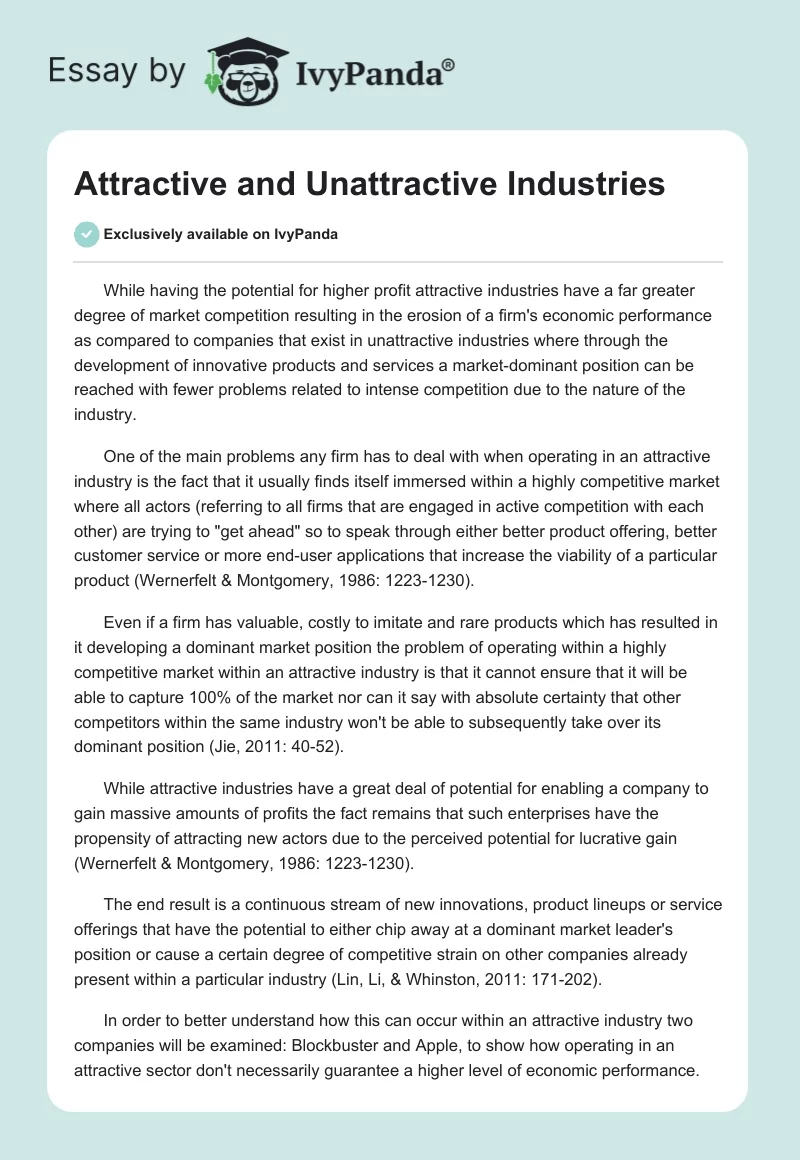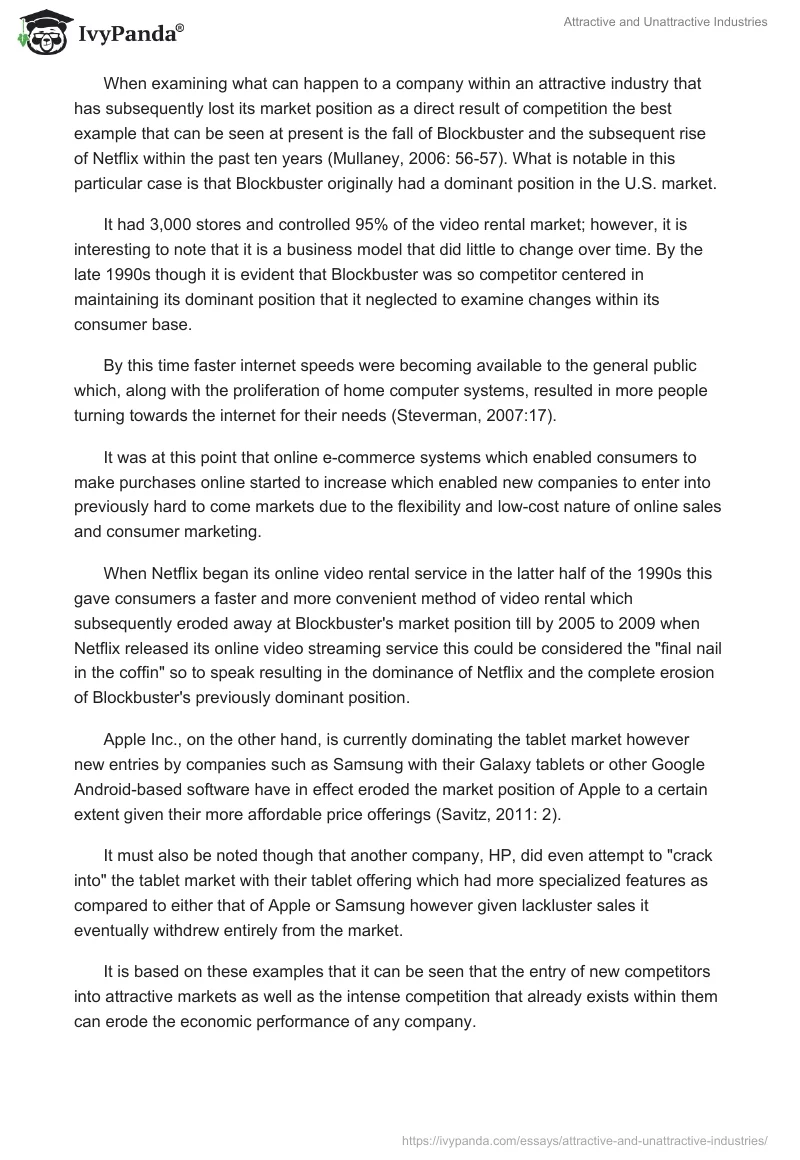While having the potential for higher profit attractive industries have a far greater degree of market competition resulting in the erosion of a firm’s economic performance as compared to companies that exist in unattractive industries where through the development of innovative products and services a market-dominant position can be reached with fewer problems related to intense competition due to the nature of the industry.
One of the main problems any firm has to deal with when operating in an attractive industry is the fact that it usually finds itself immersed within a highly competitive market where all actors (referring to all firms that are engaged in active competition with each other) are trying to “get ahead” so to speak through either better product offering, better customer service or more end-user applications that increase the viability of a particular product (Wernerfelt & Montgomery, 1986: 1223-1230).
Even if a firm has valuable, costly to imitate and rare products which has resulted in it developing a dominant market position the problem of operating within a highly competitive market within an attractive industry is that it cannot ensure that it will be able to capture 100% of the market nor can it say with absolute certainty that other competitors within the same industry won’t be able to subsequently take over its dominant position (Jie, 2011: 40-52).
While attractive industries have a great deal of potential for enabling a company to gain massive amounts of profits the fact remains that such enterprises have the propensity of attracting new actors due to the perceived potential for lucrative gain (Wernerfelt & Montgomery, 1986: 1223-1230).
The end result is a continuous stream of new innovations, product lineups or service offerings that have the potential to either chip away at a dominant market leader’s position or cause a certain degree of competitive strain on other companies already present within a particular industry (Lin, Li, & Whinston, 2011: 171-202).
In order to better understand how this can occur within an attractive industry two companies will be examined: Blockbuster and Apple, to show how operating in an attractive sector don’t necessarily guarantee a higher level of economic performance.
When examining what can happen to a company within an attractive industry that has subsequently lost its market position as a direct result of competition the best example that can be seen at present is the fall of Blockbuster and the subsequent rise of Netflix within the past ten years (Mullaney, 2006: 56-57). What is notable in this particular case is that Blockbuster originally had a dominant position in the U.S. market.
It had 3,000 stores and controlled 95% of the video rental market; however, it is interesting to note that it is a business model that did little to change over time. By the late 1990s though it is evident that Blockbuster was so competitor centered in maintaining its dominant position that it neglected to examine changes within its consumer base.
By this time faster internet speeds were becoming available to the general public which, along with the proliferation of home computer systems, resulted in more people turning towards the internet for their needs (Steverman, 2007:17).
It was at this point that online e-commerce systems which enabled consumers to make purchases online started to increase which enabled new companies to enter into previously hard to come markets due to the flexibility and low-cost nature of online sales and consumer marketing.
When Netflix began its online video rental service in the latter half of the 1990s this gave consumers a faster and more convenient method of video rental which subsequently eroded away at Blockbuster’s market position till by 2005 to 2009 when Netflix released its online video streaming service this could be considered the “final nail in the coffin” so to speak resulting in the dominance of Netflix and the complete erosion of Blockbuster’s previously dominant position.
Apple Inc., on the other hand, is currently dominating the tablet market however new entries by companies such as Samsung with their Galaxy tablets or other Google Android-based software have in effect eroded the market position of Apple to a certain extent given their more affordable price offerings (Savitz, 2011: 2).
It must also be noted though that another company, HP, did even attempt to “crack into” the tablet market with their tablet offering which had more specialized features as compared to either that of Apple or Samsung however given lackluster sales it eventually withdrew entirely from the market.
It is based on these examples that it can be seen that the entry of new competitors into attractive markets as well as the intense competition that already exists within them can erode the economic performance of any company.
On the other end of the spectrum, firms that have valuable, rare and costly-to-imitate resources and capabilities that operate in a very unattractive industry have a more significant potential for higher levels of economic performance as compared to their counterparts in attractive sectors.
What must be understood is that unattractive industries (by their very nature) have few competitors within them and have even fewer new actors that attempt to establish themselves within the market (Frenzel, 2007: 45).
Such a situation enables a company to create and maintain a dominant hold over the market resulting in what is often deemed as a monopoly over a particular product or service. For example, the company Corning is the leading producers of Gorilla glass, a stubborn form of transparent glass that is both scratch and impact resistant and is seen on most smartphones today (such as the iPhone).
Corning has such a dominant position within this particular market since it has next to no competitors, the industry is too specialized for it to appeal to other companies and the fact is that few companies have the capability to reproduce what Corning does.
All of this results in the company effectively operating within a market where it can dictate the prices, control the degree of innovation done and so long as smartphones continue to exist (which experts say could last for the next 40 to 50 years) the company in effect has a healthy consumer base.
These combined factors results in a firm that has a higher degree of economic performance as compared to others within attractive industries since those within unattractive sectors don’t have to worry about price wars, new rivals that may enter into the competitive mix or of their competitors developing new product innovations that may outperform their product offerings (Sheth, 2011:166-182).
It must also be noted that the earlier the entry of a particular firm into a specific market the more likely it is able to establish itself and create in long term survivability (Karakaya & Yannopoulos, 2011: 171-185). On the other end of the spectrum, various studies have shown that in cases where late entry was seen, there would be a lesser degree of market survivability due to the presence of already well-established brands.
Taking such factors into consideration it can be assumed that should a firm establish early entry into an attractive industry yet develop innovative products to dominate that particular industry in particular the end result would be an assured position of long term survivability with later entrants having a relatively lesser chance of establishing themselves due already dominant position of the firm that had entered the market first (this was seen in the case of Arm and Hammer and corporation which has been around for nearly a century and is still the dominant supplier of its particular industry.
Reference List
Frenzel, LE 2007, ‘Sell Phones: The Unstoppable Market’, Electronic Design, 55, 14, p. 45, MasterFILE Premier, EBSCOhost.
Jie, Y 2011, ‘The determinants of corporate growth: evidence from Chinese high technology firms’, International Journal Of Technology Management, 56, 1, pp. 40-52, Academic Search Premier, EBSCOhost.
Karakaya, F, & Yannopoulos, P 2011, ‘Impact of market entrant characteristics on incumbent reactions to market entry’, Journal Of Strategic Marketing, 19, 2, pp. 171-185, Business Source Premier, EBSCOhost.
Lin, M, Li, S, & Whinston, A 2011, ‘Innovation and Price Competition in a Two-Sided Market’, Journal Of Management Information Systems, 28, 2, pp. 171-202, Business Source Premier, EBSCOhost.
Mullaney, TJ 2006, ‘The Mail-Order Movie House That Clobbered Blockbuster’, Businessweek, 3987, pp. 56-57, Business Source Premier, EBSCOhost.
Savitz, E 2011, ‘Android Pulling Away From The Pack In U.S. Smart Phone Market’, Forbes.Com, p. 2, Business Source Premier, EBSCOhost.
Sheth, J 2011, ‘Impact of Emerging Markets on Marketing: Rethinking Existing Perspectives and Practices’, Journal Of Marketing, 75, 4, pp. 166-182, Business Source Premier, EBSCOhost.
Steverman, B 2007, ‘Netflix Battle with Blockbuster Gets Ugly’, Businessweek Online, p. 17, Business Source Premier, EBSCOhost.
Wernerfelt, B, & Montgomery, C 1986, ‘WHAT IS AN ATTRACTIVE INDUSTRY?’, Management Science, 32, 10, pp. 1223-1230, Business Source Premier, EBSCOhost.
.


